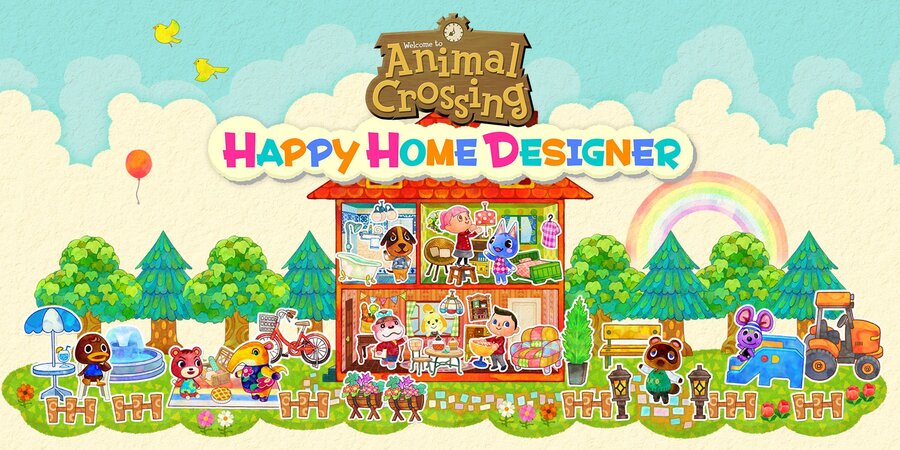
At Nintendo's E3 presentation two "spin-offs" based on the Animal Crossing series were shown: Animal Crossing amiibo Festival for Wii U, a Mario Party-style interactive board game, and Animal Crossing: Happy Home Designer for 3DS - an interior design based title.
To focus on Happy Home Designer, it left many questioning Nintendo's strategy. The general consensus was that the title seemed to be a stripped down version of the main series of games, offering players the ability to design homes with not much else on offer. It was clear to see that with the ability to design homes already being a feature of the main series of games, Happy Home Designer would have to do something unique, and would certainly need to build upon the core experience in order to be taken seriously; enticing consumers to hand over their hard earned cash.
We've been lucky enough to spend some time with Animal Crossing: Happy Home Designer, and what we saw left us feeling more positive on the upcoming release.

The first thing that becomes apparent when starting up Happy Home Designer is that this really is a true "spin-off", and besides the presentation and aesthetic style this is drastically different to the experience we've grown to know and love from the main series of games. Gone is the single village where you make your residency and in its place is a "hub" - similar to the City found from the Animal Crossing: City Folk. This is where your office and all of the action takes place. Public facilities like restaurants, shops and hospitals can also be built over time, managed by your ever-helpful assistant - Isabel - with the hub expanding as you progress.
Being a spin-off, Happy Home Designer does indeed remove many of the past-times one would expect from the usual life sim experience. You can't decide to just "go fishing" or grab a shovel and go "digging up fossils". Instead, you have a job, and your job is what you do. Where Animal Crossing represents an idealistic, quaint, relaxing way of life that many of us find so appealing due to its escapism from the hustle and bustle of our own lives, Happy Home Designer shows us what it's like to actually have a job within the universe of Animal Crossing. So put that bug-catching net away and prepare for work!
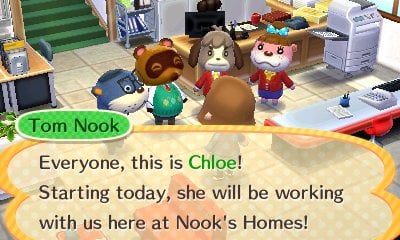
Your position is that of a realtor-designer, in charge of planning, designing and decorating homes for the numerous animals who demand your services. The animals are dictated at random, and are found wandering around the central hub. Approaching them and accepting their request is how you initiate the project, setting up a meeting in your office in order to advance the process. The first step is to chose a section of the map, each with their own terrain and characteristics. For example - you may choose to give your customer a lovely beachside home or one that sits on the edge of a river bank. The "Season" can be chosen too, giving you the choice to let an animal live in all-round scorching summer or perpetual winter - *shudders*.
Once the basics have been chosen, you go about designing the house itself. This involves picking from an ever increasing selection of wall materials, roof types, doors and fences. The combinations and styles are almost endless, and picking the right styles can be a tricky decision. When the exterior is decided upon, you can proceed to decorate the inside and (as a first for the series) the outside of the home, choosing from features such as swimming pools or sand pits. The catalogue of furniture and house styles, while being large - is still limited to begin with. However, expanding them is simple and doesn't require a daily trip to the Nook's Cranny. Upon taking a request from a critter, the relevant "set" for the request becomes available. Should your requester want a "spooky" themed home - much of the halloween set will become unlocked for that (and subsequent) home designs. This is a quick and easy way to expand upon the possibilities, and doesn't feel as time consuming or taxing as building up furniture sets did in the main series. Clients will also have a number of items awaiting unboxing when you begin a redesign that must be incorporated into the overall design, because animals can be sentimental too.
Besides this method, "courses" can be studied up back at your desk. These are exchanged for play coins, and can teach you the ability to add more forms of decorations to your home designs, such as "ceiling decorations", another all new form of adornment. The customisation is done in far greater depth and with a lot more freedom than you ever had when styling your own home in past Animal Crossing titles, which feels incredibly refreshing, and its in this ability to pick an almost endless selection of furniture in which Happy Home Designer's greatest appeal lies. Once a client's request has been fulfilled and the critter in question is satisfied, they move into their new home and your job is complete until you decide to take on the next request. Like Animal Crossing amiibo Festival, Happy Home Designer also does away with the "real-time clock" system - a feature so widely recognised with the Animal Crossing series. Instead, Happy Home Designer simply gives you a "working day". Once your tasks are complete, day turns to night and while certain facilities may become closed or unavailable, there is no pressure to end the working day until you choose to do so.
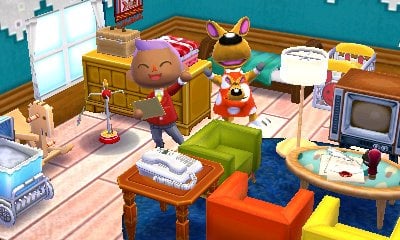
The huge expanse in customisation isn't simply limited to homes and buildings. Players now have greater control over their own appearance from the get go, allowing them to truly create an avatar of themselves. The addition of choices for skin colour is an extremely welcome feature, and hopefully one which transitions into the main series of games. Besides this, animal's clothes can be chosen and "roles" can be assigned. For example, certain animals can be chosen to teach in the nearby school, or work behind the counter in the café. Happy Home Designer really lets you play God, tailoring every minute detail to your personal preference. The most enjoyable feature, and certainly most valid "purpose" for Happy Home Designer, is to arrange these many homes and public buildings into miniature diorama like scenes. In this sense, Happy Home Designer is like a little dolls house simulator, allowing you to position the items, animals and various other features however you see fit, before utilising the many camera angles to snap the perfect shot and show off your creations to the world.
In an age where Nintendo is openly welcoming smartphone implementation of its experiences and social media implementation of its games, it isn't hugely surprising that a title like Happy Home Designer exists. In fact, were it not for it being built using the same software as Animal Crossing: New Leaf, it could easily have been a smartphone game itself. With this social media aspect in mind, Nintendo has set the real "purpose" in Happy Home Designer as gaining acceptance from your peers, with your friends and fellow 3DS owners being the only critics that really count, and this is where Happy Home Designer's questionable design choices and biggest flaws perhaps lie.
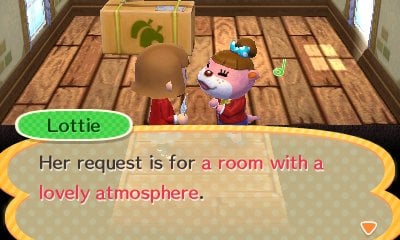
The animals will accept any design created for them, making the specific "request" almost entirely redundant. For example, designing a pink home for an animal that requests a blue one has no consequence, and the animal will be satisfied with the result. This choice further emphasises Nintendo's modern approach to video games - where the "goal" isn't self-contained in the software itself, but instead a much more social-driven one. While there's nothing wrong with Nintendo going down this road, one that is admittedly quite refreshing to see, the passiveness of these animal characters we're so used to seeing being open and honest with you is a little jarring. For a series so well loved for its depth of character - with each of the hundreds of animals having their own unique personality - it's disappointing that they should be quite so easily-pleased. Yell at us, tell us we're terrible designers - just please give us some form of constructive criticism!
The lack of feedback or parameters from the animals is where Happy Home Designer's biggest and most puzzling problems like, and are representative of Happy Home Designer as a whole - an experience with very few constraints and plenty of freedom. When designing a home, there is virtually no limit to what you can do. Furniture doesn't need to be bought, bells don't need to be spent, and your only worry is running out of floor space. As wonderful as this feels to boot up the game and have a hoard of furniture and decorations to choose from, working to a budget could only have made the experience more challenging and certainly more enjoyable. With an allowance of what could have been spent, and the possibility of not meeting the animal's expectations, players would have had more of a motive to really stop and think about just what they want to buy. Instead, almost anything can be bought and placed into a room, with the only real prohibition being your own sense of taste.
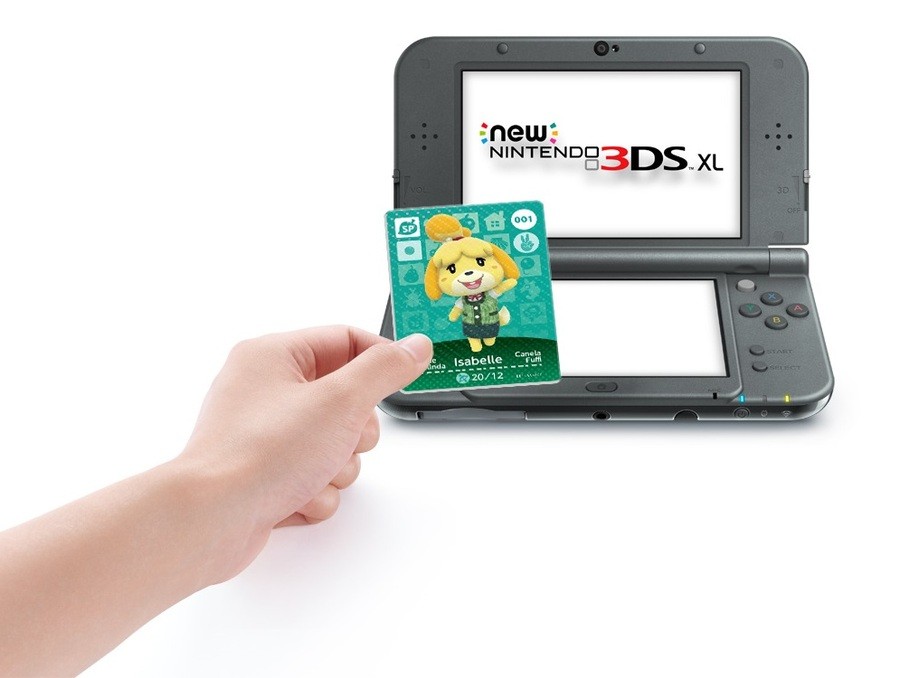
It's no secret that both Happy Home Designer and amiibo Festival were made with both amiibo figures and cards in mind, and thankfully Happy Home Designer is set to make great use of both. While the characters found within the plaza are usually randomised, by owning a specific animal in card form they can be scanned into your 3DS, making them instantly available for a home re-model.
Cards also act as a gateway to invite animals into other animals homes or public facilities. For example, while visiting Teddy after a successful remodel, scanning in Stitches would see him drop by for a visit. This is a cute way to provoke interactions between characters in a title that doesn't allow for the same degree of random interaction found within Animal Crossing's main series, and also improves the range of snapshots you can take. After all, why snap a screenshot of one animal in their abode when you can take one of two or three having a good time together? How the cards will be distributed is still unclear, but with 400 or so animals available in the game, there will potentially be a lot of card collecting going on.
While the freedom is great for the endless possibilities of snapshots, and it's nice having the ability to arrange your animals, pick out their outfits, assign them roles and ultimately dictate their very existence, the flexibility to be quite so in control of your surroundings nevertheless seems to rob Happy Home Designer of the wonderfully random aspect of the Animal Crossing series. The joy of seeing your villagers wandering around in one of your silly custom-created tees can't be replicated in Happy Home Designer, and while it's pointless to draw comparisons between Happy Home Designer and the main series of games, it's impossible to ignore the many feelings that Happy Home Designer fails to evoke that which the main series excels in. It's these absences that make Happy Home Designer feel a lot more methodical and a lot less unplanned. If Animal Crossing represents a care-free, arbitrary weekend away, Happy Home Designer resembles a structured, meticulous working week - which we suppose is rather apt.
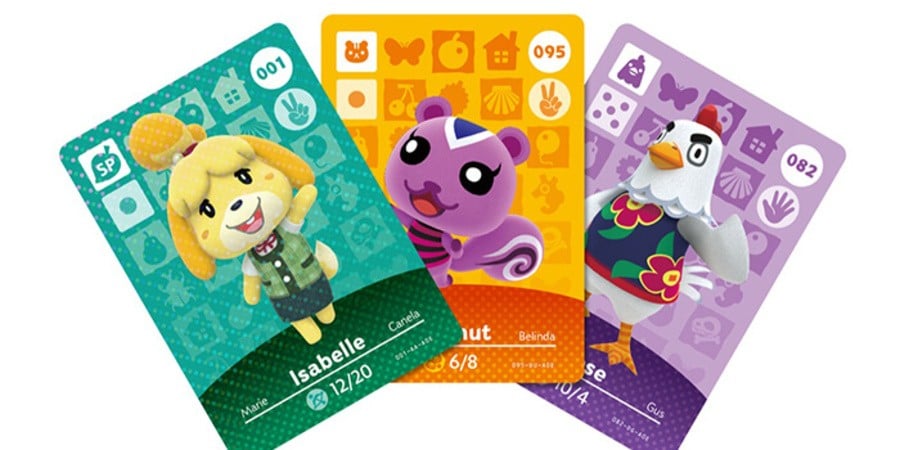
Despite the doubts, Happy Home Designer certainly is a welcome divergence for the series. The title could easily have been its own IP, giving players the ability to try their own hand at some interior design. Instead, Nintendo wisely chose to associate it with the Animal Crossing franchise, a series renowned for its charm and customisation. This choice undoubtedly makes Happy Home Designer a more appealing title, and is sure to also boost sales. However, tying the experience into such a hugely loved franchise is the sole reason for the criticism it's bound to face. It's certainly advisable to come into Happy Home Designer with a fresh perspective, dropping any preconceptions about what the game should offer, as hard as that is to do.
Ultimately, Animal Crossing: Happy Home Designer is destined to be compared to the previous Animal Crossing offerings, and in that respect it's never likely to be fully appreciated. Looking at Happy Home Designer as a standalone title, however, it's clear to see that there's a quality experience on offer here. It's far from perfect, and some odd design choices, such as the undiscerning animals and lack of constraints, result in an experience that's weaker and less rewarding than it undoubtedly could have been. With an abundance of endlessly creative possibilities, though, and impressively strong amiibo functionality, Happy Home Designer is looking very promising; we can't wait to give it a home in our 3DS collections.



Comments 48
It's definitely on the pick-up list for me, I was more into designing homes than some of the other activities in Animal Crossing, and the same went for The Sims when it first came out.
I had a feeling the game would be great. It's great to see AC get some spin-offs, instead of it usually being Mario.
The no critique thing kind of sucks, but I guess it's called Happy Home Designer for a reason.
It's nice to see that it's a good game at least, but the 180º switch from an easygoing life in a small town to a responsibility-laden job is really unfitting for Animal Crossing, which defines its core as giving the player as much freedom as one can imagine. With Happy Home Designer, the entire content is getting streamlined into a tasklist that hardly allows players to enjoy accomplishments on their own.
A gradual change, or the addition of optional career choices through a new main installment, would make much more sense than what HHD does without any warning. Good game, bad Animal Crossing.
This game isn't putting lead in my pencil. Wake me when they make a real AC experience.
Day one for me!!! Can't wait!
Haven't started New Leaf so not sure about this one.
@rjejr
Happy Home Des.... er, Happy Birthday#17!
I was thinking about getting this but now i think ill pass...
I was on the fence about this one when I heard about it but after the article, this will be one for me to preorder.
Still on the fence. The negatives expressed about this game are pretty big negatives, in my opinion. If there are no constraints or consequences for failure, this could become boring very quickly. Price is also an issue for me: I don't see myself spending $39.99 on this game so I'm interested to see how Nintendo prices it. It honestly sounds and looks kind of like a $15-20 eShop title to me.
The main problem I have with this game is that there only appears to be one thing to do in it: designing homes. What I love about other Animal Crossing games is that there's plenty of different things to do in them, such as fishing or shopping. Plus, designing homes is my least favourite part of Animal Crossing. I always just put items I like wherever there happens to be space, and then do other stuff in the game.
Hmmm I'm now genuinely interested in this, we shall see how things work out.
I will probably buy this but I have mixed feelings about it.
One of my favourite things about Animal Crossing has always been the real world time clock and the associated seasonal events (Christmas, Halloween, Birthday etc.). It is always fun to visit your villagers and have them share in those special days with you. With the clock missing from this game, I think that may also mean that the seasonal events will not be there either.
A game for the toilet (not sitting on it, in the toilet) if someone gives it too me.
I can't wait to play it. As much as I love Animal Crossing New Leaf, it kind of gets boring just fishing an catching bugs all day. I can't wait to try my hand at home design. To me this is a nice companion game to New Leaf. I love designing my rooms in New Leaf.
I thought that getting comfortable with, was written as "cozy", not "cosy".
@maceng British English - American English
So they've removed the loveable snarkiness and replaced it with characters who want you to design their homes to certain specifications but don't care if you give them the opposite.
No bells needed, everything is available as soon as it's needed, no complaints from the Stepford citizens...what's the point?
I feel like the fact that they're cool with whatever you design makes this kind of worthless. If I wanted to design a home the way I wanted it with no other requirements, I would just play Animal Crossing.
The more I read about this more I'm interested in it. It seems like an interesting little spin off to New Leaf. A, 230 hour+ adventure like New Leaf??? Nope, but a fun little romp through the Animal Crossing universe.
Day one buy for me aaaa!!!
The cards remind me of the old Animal Crossing cards for the e-reader on that unlocked things for the Gamecube version of AC
There's plenty here that I'd like to see in the next AC game, like being able to design villagers houses, and items that can be placed outdoors. If the cards could permanently invite a villager to your village that would be awesome.
I have no interest in this game, but it seems like an excellent strategy to sell amiibo cards and New 3DSs to use those amiibo cards.
It doesn't look bad, but I'm not going to buy something that seems like it should be an $8 eshop release for full retail price.
This is a day-one buy for me. I work in the Real Estate world and have always wanted to stage vacant homes. Now I can on my 3DS
All you do is design homes in this. Where's the town you live in or the villagers that live there? I am disappointed, but I'll probably still get it because it's Animal Crossing... or it sort of is.
Furry Crossing: Creepy Neckbeard Designer
"When the exterior is decided upon, you can proceed to decorate the inside and (as a first for the series) the outside of the home, choosing from features such as swimming pools or sand pits."
Sand pits? Is that like a swimming pool for snakes and animals who can't go in water? Or is it something people have in real life?
Silly questions aside, I'm on the fence with this game. Just designing houses seems boring to me, because AC was where I filled up the museum; I never really concentrated on my house. However, I'll wait until it's released to truly decide.
Good read. I was looking forward to this game, but reading that there is no actual "scoring" of your design by the villagers makes me question how much actual fun this will be beyond a couple hours. I was expecting grades or something, at least some kind of basic check by the computer that you made the walls blue when the villager asked for blue walls. To not have even that just seems pointless. So now I'm much less excited for this, and will probably divert my hype towards amiibo festival instead. Hopefully that turns out better!
@sinalefa - Not on my birthday wish list. Too bad Godzilla is $50 and 1 player. Maybe if I could get an amiibo Godzilla and have him invade Animal Crossing I'd be into it.
I'm more interested in making my village look nice. Designing my rooms has always been a chore I didn't like. I'd be more interested if the animals could tell me I had an eye for design like a dead yak.
I will definitely pick this up if it comes with the nfc reader for the 3ds. If it doesn't, I'll probably pick it up anyway.
Now see, this is more welcome than Amiibo Festival for the simple reason that the 3DS has already gotten its main series AC game. It looks interesting, and I'm actually pleased to hear that there won't be a "budget limit". Some general criticism from the clients when you goof up would have been nice, though.
This, Zelda Three-Swords (lol), and Mario & Luigi: Paper Jam are all on my to-get list.
Give your villager one chair and your pretty much set!
huh...
I want a Biskit card...
While I like others was sceptical of this game when it was first announced I now consider this to be a day one purchase for sure. Designing my home was always one of my favorite parts of Animal Crossing and having based specifically around that sounds perfect and right up my alley!
Hmmm....I'm still super undecided. I'm really glad you finally confirmed that I don't have to do what the animals say. When I heard about the game I got excited cause I never really got to design my home in the last AC (by the time I had the furniture I wanted I was sick of the game and every day I had to do 15 min of shores before being ready do design). But having no restrictions at all, I'd rather have this be a simple Home Designer (without the happiness ) for a couple of bucks in the eshop. I'm also super disappointed about the Amiibo function.The cards look awesome, but this whole photo-op thing is typical for Nintendo: It's fun to try it once or twice, have a laugh, and never ever do it again.
I'm still looking for reasons to justify the existence of such thing as a full game (it could perfectly fit as an extra feature inside a potential Wii U entry) but I still haven't found any.
Nintendo way to earn extra money like always.
I loved ACNL so this is still going to be a preorder for me. However, it's EXTREMELY disappointing that designs aren't graded somehow. I kinda assumed this game would be like the coffee shop in ACNL where you had to make their order a specific way to get a perfect "rating" from the animals. Really disappointed, actually. Hopefully, this is an early build and this is actually built into the game... But it doesn't sound like it.
I really don't think this looks very interesting and I love Animal Crossing. This seems like an eshop type release to me.
Nintendo milking the A.C. brand. If they had released a proper A.C. game alongside to the Wii U I might have been interested in the cards and amiibos. Not now.
@rjejr
someone should invite you to the amiibo planning board at Nintendo for a day. it would be so fun to see different amiibo visit and try to make sense of living in animal crossing. Mario could jump all the pits and install pipes and plant mushrooms, Bowser could get angry and stomp around a la Godzilla. Pax man could eat all the fruit off the trees and make ghosts appear in the houses. It would be like disasters in sim city.
On this game: it would be much nicer to have at least an optional track that rewarded you for better matches to their wishes and especially bell limits rather than just space limits. But for some who are about sharing pictures the real life rewards have the potential to be much more compelling. Still an attached number of how well it matched and how many bells it cost would still be valuable.
Seems like a misstep to me.
As an inexpensive game to encourage amiibo card trading it sounds good though. Let's see how it's marketed.
@aaronsullivan - "invite you to the amino planning board at Nintendo"
If they did invite me I wouldn't go, I've seen Goodfellas.
I already put money down on it, it looks cute and I remember having more fun, designing my SIMS house, then I did playing with the people.
Ehhhh....I almost feel used. Between this and the soulless Animal Crossing Party, where both almost demands you to buy cards and figurines in order to fully enjoy the game you paid full price for. It feels so transparent, and I'm not gonna pretend that Nintendo is a heartfelt charity - of course they're here to make money. But it always felt fair before all this, like I was valued and respected as a customer. Now it feels as though they're insulting my intelligence and trying to fleece me by putting the bare minimum and slapping on a recognized title.
I'm not saying that I won't buy it, but I'm gonna wait a few months after the US release. Gonna see some reviews, gonna watch some youtube vids. Because, what I'm seeing so far barely sounds like a game (no grading system???). There seems to be a lot of unsure people who are going full steam anyway, because of brand loyalty. Please don't do that. Actions like that will only encourage them to continue their attempts to charge us twice for half the product.
...with all of that being said, it would be interesting if they implant the building customization and town decorations into future Animal Crossing games.
Show Comments
Leave A Comment
Hold on there, you need to login to post a comment...